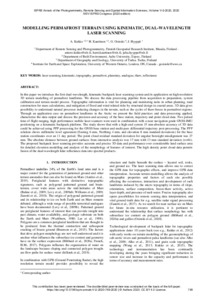Modelling Permafrost Terrain Using Kinematic, Dual-Wavelength Laser Scanning
Kukko A.; Hyyppä J.; Osinski G.; Kaartinen H.
https://urn.fi/URN:NBN:fi-fe2021042827389
Tiivistelmä
In this paper we introduce the first dual-wavelength, kinematic backpack laser scanning system and its application on high resolution 3D terrain modelling of permafrost landforms. We discuss the data processing pipeline from acquisition to preparation, system calibration and terrain model process. Topographic information is vital for planning and monitoring tasks in urban planning, road construction for mass calculations, and mitigation of flood and wind related risks by structural design in coastal areas. 3D data gives possibility to understand natural processes inducing changes in the terrain, such as the cycles of thaw-freeze in permafrost regions. Through an application case on permafrost landforms in the Arctic we present the field practices and data processing applied, characterize the data output and discuss the precision and accuracy of the base station, trajectory and point cloud data. Two pulsed time of flight ranging, high performance mobile laser scanners were used in combination with a near navigation grade GNSS-IMU positioning on a kinematic backpack platform. The study shows that with a high-end system 15 mm absolute accuracy of 3D data could be achieved using PPP processing for the GNSS base station and multi-pass differential trajectory post-processing. The PPP solution shows millimetre level agreement (Easting 6 mm, Northing 4 mm, and elevation 8 mm standard deviations) for the base station coordinates over an 11 day period. The point cloud residual standard deviation for angular boresight misalignment was 27 mm. The absolute distance between ground surfaces from interactive analysis was 17 mm with 13 mm standard deviation (n = 64). The proposed backpack laser scanning provides accurate and precise 3D data and performance over considerable land surface area for detailed elevation modelling and analysis of the morphology of features of interest. The high density point cloud data permits fusion of the dual-wavelength lidar reflectance data into spectral products.
Kokoelmat
- Rinnakkaistallenteet [19207]
